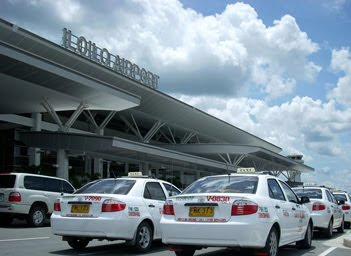Cebu-Pacific will soon launch its Iloilo-Hongkong flights, and the Korean Airlines will also mount its South Korea-Iloilo flights, Mendoza said during the ground-breaking ceremony of the P124-million secondary access road in Brgy. Tabucan, Cabatuan leading to the Iloilo Airport on Friday.
Text and photos courtesy of PANAY NEWS
President Gloria Macapagal-Arroyo has ordered to establish an international desk at the Iloilo Airport. It will be administered by the Customs Immigration and Quarantine.
“The Iloilo Airport is now complete,” declared Mendoza as he emphasized that the airport has already been declared an “international destination.”
He expressed confidence that with the international flights, investors will come in to spur economic development in Region 6.
This could be achieved because of the potential of the area near the airport to become an industrial zone, “eventually becoming an economic zone,” Mendoza explained.
It was the Regional Development Council (RDC), the highest policy-making body of Western Visayas, that lobbied to make the Iloilo Airport service international flights.
Though of international standards, the Iloilo Airport presently accommodates local flights. Two Western Visayas airports already accommodate international flights – the Godofredo P. Ramos Airport in Caticlan, Malay, Aklan and the Kalibo International Airport in Kalibo, Aklan.
If the Iloilo Airport is made to service international flights, it could generate an average daily income of P280,000 from terminal fee collections, a study of RDC’s Regional Project Monitoring Committee showed.
The airport currently serves 16 outgoing flights daily, with an average volume of 90 passengers per flight.
Straddling Sta. Barbara and Cabatuan towns 19 kilometers northwest of Iloilo City, the Iloilo Airport opened its doors to commercial traffic on June 14, 2007 after a decade of planning and construction, replacing Mandurriao airport in the city which had been in service for over 70 years.
The airport is officially designated as a Class 1 principal (major domestic) airport by the Civil Aviation Authority of the Philippines, the body responsible for the operations of all airports in the country.
The airport sits on a 188-hectare site. It consists of a single runway, various administrative and maintenance buildings, waste sorting and water treatment facilities, a power generating station, a cargo terminal and a main passenger terminal.
Unlike the runway in Mandurriao, the longer runway at the new Iloilo Airport can support aircraft as large as the Airbus A330. Runway lights and an Instrument Landing System were installed, making it capable of supporting low-visibility and night landings.
Its location on the Tomas Confesor Highway, a major highway traversing Panay Island, makes the airport accessible from all parts of Iloilo and Panay by road, while its proximity to the currently defunct Panay Railways network could potentially link the airport to the rest of Panay by rail..... READ MORE
UPDATE 11/09/09
Buddy Britanico of the Banat Party-list is running for reelection.Because of his sterling performance in the House of Representatives, the Ilonggos will certainly support him again. Buddy, one of the country’s most outstanding parliamentarians, is responsible for the opening of the Iloilo Airport to international flights, which will start this December.
He is also responsible for the modular generator sets that the National Power Corporation will provide Iloilo City to solve the perennial problem of terrible brownouts that drive away businessmen and investors.It should be remembered that it is also Britanico, former Minister of the Department of Education, who brought the University of the Philippines to Miag-ao.Britanico’s presence in the House of Representatives gives prestige to the Ilonggos long deprived of good congressional representation.Kudos to Buddy!
